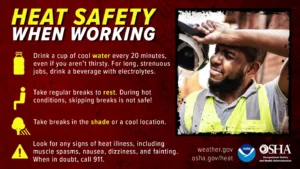By Liz Stevens
“Hottest day,” “hottest month,” “hottest summer,” “hottest year,” – these headlines reflect the rising temperatures around the nation and across the globe. OSHA is addressing the issue of heat’s effects on workers and their health, and so are the states. This double bonus Top 5 article looks at OSHA headlines and resources, as well as some important news and study results to help industries stay ahead of the next heat wave.
Top 5 News Items and Resources
News: OSHA Takes Heat Very Seriously
In January of 2023, OSHA published its first issue of Heat Source, the newsletter of the agency’s Heat Illness Prevention campaign. The campaign educates employers and workers on heat hazards and provides resources to keep workers safe.
The newsletter included tips on determining hydration levels, an update from the National Advisory Committee on OSHA’s work group on heat injury and illness prevention, and the winners of the Let’s Talk About Heat Challenge.
To subscribe to the monthly newsletter, visit osha.gov/heat.
For more valuable information about the Heat Illness Prevention campaign, visit https://www.osha.gov/heat.
News: Extreme Heat – This is Not a Test
In July of 2023, OSHA issued its first hazard alert on heat, urging employers to take steps to keep workers safe in extreme heat, including providing adequate cool water, rest breaks, and shade or a cool rest area. The alert also urged employers to:
“Give new or returning employees a chance to gradually acclimatize to high-heat conditions, provide training and plan for emergencies, and monitor for signs/symptoms of heat-related illness.
Train employees on heat-related illness prevention, signs of heat-related illness, and how to act if they or another employee appears to be experiencing a heat-related illness.”
In addition to issuing alerts, OSHA has increased inspections in high-risk industries. For more information on OSHA’s national emphasis program on heat hazards, see www.osha.gov/sites/default/files/heat-nep-factsheet-en.pdf.
Resource: Tools and More to Beat the Heat
In August 2023, OSHA announced winners of its ‘Beat the Heat’ contest which challenged stakeholders to submit tools and resources related to heat exposure at work. OSHA sponsored the contest to raise awareness of the dangers of heat exposure in indoor and outdoor workplaces – an important step in educating workers and employers to recognize when heat is affecting workers’ health and safety, and how to protect them. Winners included:
O’Donnell/Snider Construction’s “Heat Safety Quick Guide,” which provides information on the dangers of working in hot environments and creating a heat safety plan. See it at www.osha.gov/sites/default/files/2023BeatTheHeatWinners/Contest_Message_ODonnellSniderConstruction_508c.pdf.
Cleaveland/Price Inc. with a heat illness training video focusing on the dangers of becoming overheated, the effects of heat-related illnesses, signs and symptoms, and what to do when heat-related illnesses occur. View the video at https://cleavelandprice.vids.io/videos/d39cdbb51715eacf5a/beat-the-heat-mov.
Primoris & ReadyKey’s smart phone app featuring information and resources provided by Primoris, ReadyKey, BSI, OSHA, NIOSH and additional public sources. The app has important lessons and tools to keep close by as temperatures rise. The app is available at https://itunes.apple.com/us/app/id6462538074 and https://play.google.com/store/apps/details?id=com.guidebook.apps.heat.android.
To see all of the ‘Beat the Heat’ winners, visit www.osha.gov/heat/national-heat-contest.
For more resources on hazardous heat, visit osha.gov/heat.
Resource: Work Safely Infographic
OSHA and NOAA teamed up to produce this concise, effective infographic on working safely in the heat.
Resource: Info on Wearable Heat-Monitoring Technology
“Prevent work-related heat stress,” a June 25, 2023 Safety+Health article, posed the question “How can wearable technology change the way employers implement heat stress monitoring?” In the article, author Leon Marsh, founder and CEO, Bodytrak, discussed the value of wearable devices that are advanced beyond fitness trackers and smartwatches. Marsh described a temperature monitor that is worn in the ear, that can alert the wearer when body temperature rises and that also can provide data to be analyzed for patterns and trends in a workplace.
See the entire article at www.safetyandhealthmagazine.com/articles/prevent-work-related-heat-stress
Top 5 Pieces of Illuminating Intelligence
Report: Adapting industry to withstand rising temperatures and future heatwaves
This report from the Institution of Mechanical Engineers, published in 2023, looks at how industries can prepare for heat waves and rising temperatures. Heat waves are increasing and have become the cause of most weather-related deaths. On the job, heat waves make the workplace uncomfortable and unsafe since excessive heat affects workers’ cognitive abilities, can lead to poor decision-making and can tempt workers to eschew PPE in order to stay cooler.
The report “outlines the urgent need for engineering related standards and design codes to be based on expectations of future climate rather than past climates, adaptation solutions to be sustainable and result in net-zero greenhouse gas emissions, and strategies to be developed to make workplaces and work practices comfortable and safe.” It concludes with key recommendations for action.
Download the report at https://www.imeche.org/docs/default-source/1-oscar/reports-policy-statements-and-documents/imeche-heat-adaptation-report.pdf?sfvrsn=b5026411_2.
Get a summary of the report for policymakers at https://www.imeche.org/docs/default-source/1-oscar/reports-policy-statements-and-documents/imeche-heat-adaptation-summary.pdf?sfvrsn=2.
Study: Analysis of Exertion-Related Injuries and Fatalities in Laborers in the United States
This study, published in 2023 in the International Journal of Environmental Research and Public Health, is from researchers at the University of Connecticut who examined OSHA reportable data and reports to characterize the top causes of exertional injury and fatality among laborers.
The researchers found that “heat-related injuries encompassed 91.9% of the exertional injuries.” Among exertion-related fatalities, nearly 90% consisted of heat-related cases. “Exertion-related injuries and fatalities were most reported in Southeast states,” according to the study, “in the construction and excavation industry, and among nonunionized workers.”
The researchers note that heat-related injuries are probably vastly underreported. And heat stress, while predominantly experienced by construction and excavation workers, nonunionized workers and workers in Southeastern states, affects many more industries and locales, and will likely only rise in the coming years.
To read the study, visit www.mdpi.com/1660-4601/20/3/2683.
Article: The Cost of Heat-related Illnesses
In “The cost of heat-related illnesses. How significant are the differences in cost between preventing and treating heat-related illnesses?,” a Safety+Health April 2023 article, Nick Hernandez, global account manager, and Kyle Hubregtse, CEO, Kenzen, Kansas City, Missouri, cite OSHA’s Safety Pays Individual Injury Estimator as indicating that it can cost an employer nearly $80,000 in direct and indirect costs for a single incidence of overheating related to extreme weather conditions.
“As global temperatures continue to rise as a result of climate change,” write the authors, “so too does the number of workers at risk of heat-related illnesses. Despite these illnesses and fatalities being preventable, millions are affected each year. The Atlantic Council reports that extreme heat is associated with 8,500 excess deaths annually and estimates a nearly sevenfold increase to 59,000 by 2050. This can lead to global instability and cost the global economy $2.4 trillion every year by 2030, the International Labour Organization says.”
The authors go on to note that in preventing heat-related illnesses, hydration alone is not a reliable preventative or remedy, and they point to wearable technology (their company, Kenzen, markets wearable heat and safety monitoring devices) as a cost-effective preventive measure. Wearable technology that monitors physiology and warns users of overheating can range from $150 to $1,000 yearly, a drop in the bucket compared to the cost of one instance of heat exhaustion in a worker.
To read the article, visit www.safetyandhealthmagazine.com/articles/23813-the-cost-of-heat-related-illnesses.
Article: Heat’s Effects, Cooling Gizmos, Monitoring Devices
In his 2023 Washington Post article, “Employers turn to ice vests, sweat stickers to cope with extreme heat,” author Jacob Bogage describes some of the cooling vests, shade canopies, misting stations and other equipment that employers have deployed to keep workers cool on scorching days. He also describes some of the skin patches and other wearable monitors available.
Bogage takes a deep look at what happens to the human body during overheating: the heart pumps more blood to the surface of the skin, and people sweat for evaporative cooling but this depletes the body’s fluids and affects the blood supply. At 100.4 degrees F, the body begins to reserve blood supply for the most vital organs. After that, body temperature rises dramatically in an effort to fight back but this only compounds the problem.
While the technological innovations may be promising, they do not take the place of the basics for workers on hot days – shade, rest and water. “Water replenishes fluid, which ensures there’s enough blood in the body and allows you to keep sweating,” Bogage writes. “Rest slows or stops aerobic activity, so your muscles don’t produce as much heat. Shade gets you out of direct sunlight, giving your body the ability to radiate heat to your surroundings.”
To read the entire article, visit www.washingtonpost.com/business/2023/09/08/heat-climate-work-tech.
Articles: Federal and State Efforts to Protect Workers
In his 2023 New York Times article, “Workers Exposed to Extreme Heat Have Few Protections,” author Noah Weiland examined the status of OSHA federal guidelines for indoor and outdoor work in heat while illustrating the effect of extreme heat through examples of affected workers at the Dallas Fort Worth International Airport.
Some key takeaways:
- Excessive heat now is affecting more of the US, including states with typically milder climates.
- In 2021, more than 2.5 billion labor hours were lost to heat exposure in US agriculture, construction, manufacturing and service sectors.
- “Extreme heat can wreak havoc on the body’s major organs. The heart and the kidneys can become deprived of blood and oxygen, leading to kidney failure. If the brain becomes overheated and oxygen-deprived, it can halt the signals to the body to cool itself, preventing sweat.”
- People with epilepsy, like one airport worker featured, are more prone to seizures in extreme heat.
- OSHA has a lengthy process for its rule-making and may be ready to lay out a timeline for its rule proposal in early 2024.
- Health experts say that federal guidelines (and enforcement) for employers regarding extreme heat will be a “game changer” and “save lives.”
Read the article at www.nytimes.com/2023/10/05/health/heat-exposure-workers-osha.html.
Kevin Druley’s 2023 Safety+Health article, “What’s being done to protect workers from heat illness?,” takes a look at states’ efforts to keep workers safe.
California, for example, has had a heat standard for outdoor workers in effect since 2005, requiring access to water and shade and an effective heat illness prevention plan.
In Minnesota, the state’s rule for indoor air temperatures prohibits worker exposure to heat above 86 degrees F for light work, 80 degrees F for moderate work and 77 degrees F for heavy work.
Pending legislation in Nevada calls for training programs for employees on heat-related illness issues, a program to mitigate heat-related illness on any day when the temperature is expected to exceed 95 degrees F, a 10-minute rest break each hour, access to shade and at least a quart of cool drinking water.
Read more at www.safetyandhealthmagazine.com/articles/24142-whats-being-done-protect-workers-heat-illness.






